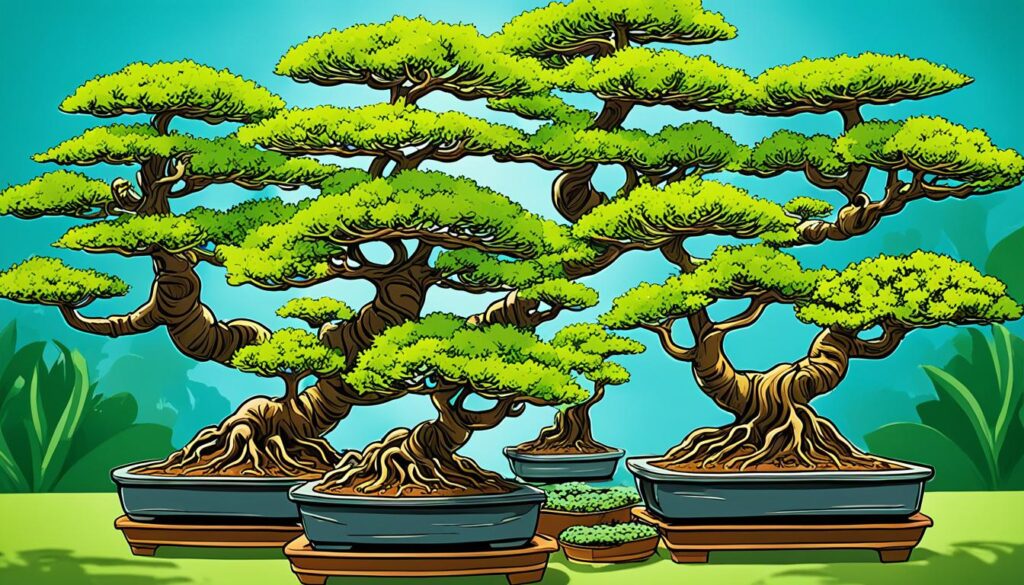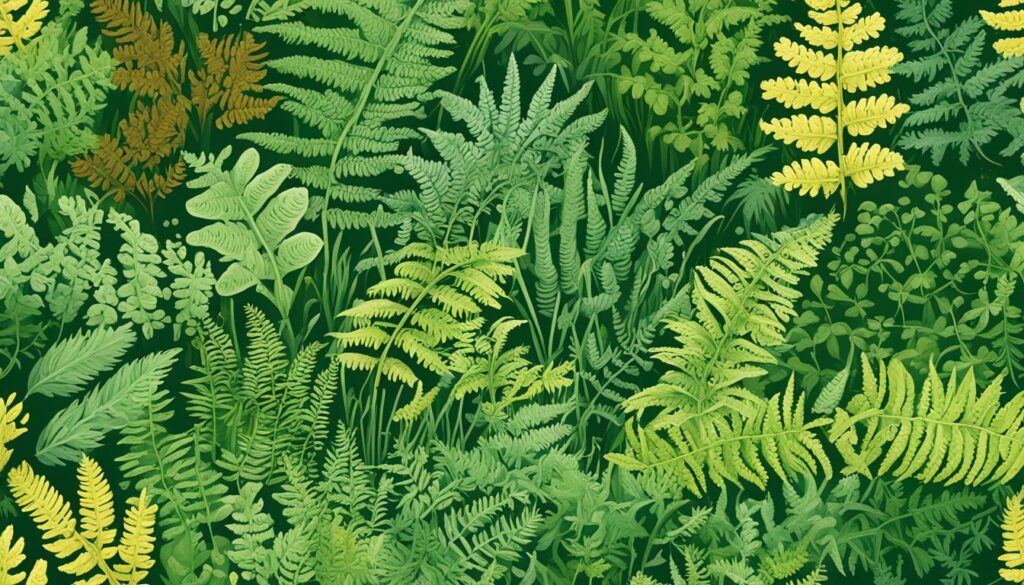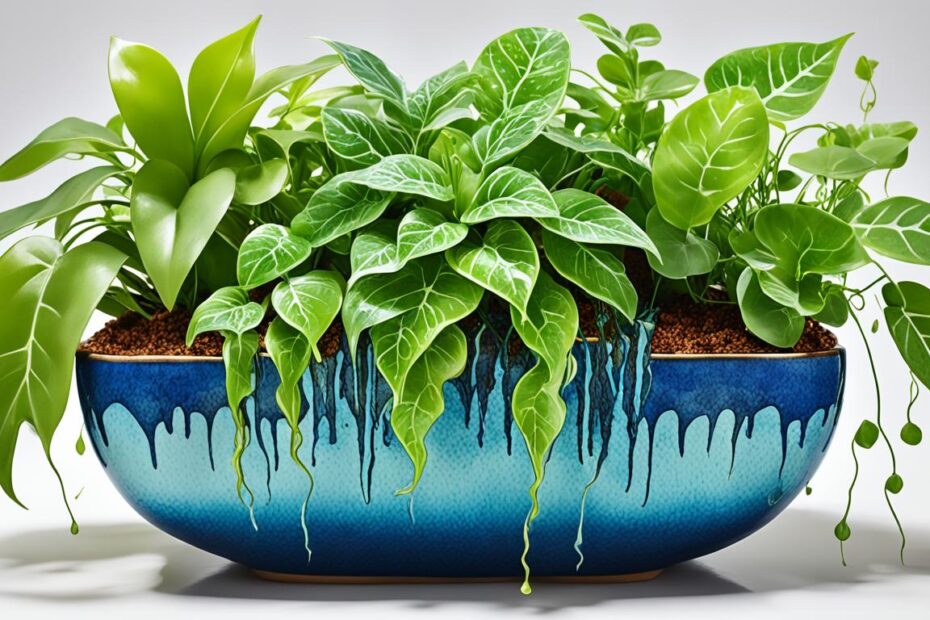Houseplant owners often find themselves in a dilemma when it comes to watering their plants. Overwatering can lead to root rot and other issues, leaving many unsure of how much water is too much. But what if we told you that there are indoor plants that actually thrive in wet soil conditions?
Whether you have a tendency to overwater or simply want to add some moisture-loving plants to your collection, we’ve got you covered. In this article, we’ll explore 10 incredible indoor plants that not only tolerate wet soil but actually thrive in it. Get ready to create a lush and vibrant oasis in your home!
Key Takeaways:
- Overwatering your indoor plants can lead to root rot and other issues.
- There are indoor plants that love wet soil and can thrive in it.
- Adding moisture-loving plants to your collection can create a vibrant and lush indoor oasis.
- Explore 10 great indoor plants that enjoy wet soil conditions.
- Don’t be afraid to experiment and find the perfect plant for your space!
Bird of Paradise ‘White’ 10″
Transform your indoor space into a lush tropical paradise with the stunning Bird of Paradise ‘White’ plant. With its dramatic, long, arching leaves and intense exotic flowers, this plant is sure to make a bold statement in your home.
What sets the Bird of Paradise ‘White’ apart is its ability to thrive in moderate to high soil moisture levels. If you have a tendency to water your plants generously, this plant is a perfect choice for you. It can handle wetter conditions with ease, making it an ideal addition to your collection of indoor plants that like wet soil.
But there’s more to love about this beautiful plant! Its large, showy flowers resemble the plumage of a tropical bird, which is how it earned its name. The vibrant white flowers stand out against the lush green foliage, creating a stunning contrast that will bring a touch of exotic beauty to any room.
Whether you place it in a well-lit corner, near a sunny window, or as a centerpiece in your living room, the Bird of Paradise ‘White’ will undoubtedly become the focal point of your indoor garden. Its bold and vibrant presence will bring a sense of tropical flair and natural elegance into your space.
How to Care for Bird of Paradise ‘White’ Indoor Plant
If you’re ready to give your Bird of Paradise ‘White’ the care it needs to thrive, here are a few tips:
- Place your plant in a brightly lit area where it can receive indirect sunlight.
- Water it regularly, keeping the soil moist but not soggy. Ensure proper drainage to prevent waterlogging.
- Maintain moderate to high humidity levels by misting the leaves or placing a humidifier nearby.
- Feed your plant with a balanced fertilizer during the growing season to promote healthy growth.
- Keep in mind that the Bird of Paradise ‘White’ can grow quite tall, so make sure to provide adequate space for its impressive foliage and flower display.
With the right care and attention, your Bird of Paradise ‘White’ will reward you with its stunning beauty and vibrant presence. Shop now and bring the allure of the tropics into your home with this exceptional indoor plant that thrives in wet soil conditions.
Bonsai Trees
Bonsai trees are a fascinating and captivating addition to any indoor gardening space. These miniature trees, carefully pruned and shaped over time, are a reflection of patience, artistry, and nature’s beauty. If you’re looking for indoor plants that like wet soil, bonsai trees are an excellent choice.
While Juniper varieties are commonly used as starter plants for bonsai beginners, there is a wide selection of other options to explore. Each variety offers its own unique charm and character, allowing you to find the perfect bonsai tree that suits your aesthetic preferences.
These meticulously crafted trees are not only beautiful to look at but also have a remarkable ability to withstand moist soil conditions. This makes them well-suited for indoor environments where careful watering can sometimes be a challenge.
Exploring Bonsai Styles and Varieties
One of the most fascinating aspects of bonsai trees is the endless variety of styles and species to choose from. Each style represents a different aesthetic, ranging from the formal and upright “Chokkan” style to the windswept and dramatic “Fukinagashi” style.
Some popular bonsai tree species that thrive in wet soil conditions include:
- Japanese Maple
- Ficus
- Chinese Elm
- Schefflera
These species are known for their adaptability and ability to tolerate higher moisture levels, making them suitable for indoor environments.
If you’re a beginner in the art of bonsai, it’s essential to do your research and ensure you understand the specific care requirements of each bonsai tree species. This will help you create the ideal environment for your bonsai tree to flourish.

“The bonsai tree is not the work of a single day or month; rather, it is a testament to the careful cultivation and nurturing of nature’s beauty.”
Incorporating bonsai trees into your indoor garden can provide a sense of tranquility, connection with nature, and a unique aesthetic appeal. Whether you choose a traditional Japanese maple bonsai or a tropical ficus bonsai, these living masterpieces will surely captivate your attention and foster a deep appreciation for the art form.
Carnivorous Plants
Looking to add some unique and fascinating plants to your indoor collection? Look no further than carnivorous plants! These extraordinary plants not only capture your attention with their intriguing appearance but also make them a perfect choice for those who tend to overwater their plants. Carnivorous plants, such as Venus Fly Traps and Pitcher Plants, are hardy and can tolerate moderate to high soil moisture levels, making them suitable for wet conditions.
What sets these plants apart is their unique ability to attract, capture, and digest insects. They have specially adapted leaves that serve as traps, luring unsuspecting insects into their clutches. This evolutionary adaptation allows carnivorous plants to supplement their nutrient intake, as the soil they typically grow in lacks essential nutrients. So, if you’re looking to add a touch of intrigue to your indoor garden and embrace your green thumb even if you tend to be heavy-handed with the watering can, carnivorous plants are an excellent choice.
“Carnivorous plants are not only captivating to behold, but also have the ability to thrive in wet soil conditions. They offer a unique approach to gardening by providing an interactive experience, as you witness these plants trapping and consuming insects. It’s like having a mini-ecosystem in your own home!”
You may be wondering, are carnivorous plants safe to have around pets? According to ASPCA.com, many carnivorous plants are considered “pet friendly” and pose no threat to your furry friends. However, it’s always a good idea to ensure your pets don’t ingest or play with these plants, as it may disrupt their natural growth patterns.
Ready to welcome these captivating insect-eating wonders into your home? Explore a variety of carnivorous plant options sourced from reputable plant sellers and nurseries. With their otherworldly appearance and unique growing requirements, these plants are sure to be a conversation starter and a fascinating addition to your indoor garden.
The Different Types of Carnivorous Plants
Carnivorous plants come in various forms and trap mechanisms, each with its own captivating features. Here are a few examples:
- Venus Fly Trap (Dionaea muscipula) – Known for its iconic snapping-trap mechanism that captures insects when triggered by their movement.
- Pitcher Plant (Nepenthes) – Features specialized pitcher-like structures that attract and drown insects in a pool of digestive enzymes.
- Sundew (Drosera) – Characterized by their unique tentacle-like glands that secrete sticky mucilage, trapping and digesting insects.
- Bladderwort (Utricularia) – Utilizes tiny, bladder-like structures that create suction to capture microscopic organisms in water.
Each type of carnivorous plant offers a mesmerizing display of nature’s ingenuity and adaptability. You can select the species that captivate you the most and suit your indoor gardening preferences.
Citrus Plants
Looking to add a touch of freshness and flavor to your indoor garden? Citrus plants are the perfect choice. Not only are they incredibly fragrant, but they also thrive in moist soil conditions, making them ideal for those who prefer plants that like wet soil.
Imagine harvesting your own juicy and flavorful fruits right from the comfort of your home. With citrus plants like Meyer Lemon and Key Limequat, you can enjoy year-round availability of these delightful treats. Let the tantalizing aroma of fresh citrus fill the air, invigorating your senses and adding a burst of color to your space.
“Citrus plants not only offer a beautiful addition to your indoor garden, but the fruits they bear can also be used in various culinary creations. From zesty lemonades to tangy marinades, the possibilities are endless. Plus, the vibrant colors of their fruits bring a cheerful ambiance to any room.”
Health Benefits of Citrus Fruits
The benefits of citrus fruits extend beyond their heavenly taste. These vitamin-rich powerhouses are known for their numerous health benefits, including:
- Boosting immune function
- Improving digestion
- Supporting heart health
- Enhancing skin complexion
- Aiding in weight management
- Reducing the risk of certain diseases
So not only are citrus plants a feast for the eyes and taste buds, but they also contribute to your overall well-being.
Caring for Citrus Plants
While citrus plants require adequate moisture, it’s important not to overwater them. Ensure the soil is consistently moist but not waterlogged, as this can lead to root rot. A well-draining potting mix is essential for maintaining the right balance of moisture.
| Light | Watering | Temperature |
|---|---|---|
| Bright, direct sunlight for at least 6-8 hours a day | Water when the top inch of soil feels dry | 65-85°F (18-29°C), with some tolerance for cooler temperatures |
Remember to fertilize your citrus plants regularly with a balanced citrus-specific fertilizer to provide them with the necessary nutrients for healthy growth. Pruning may be necessary to promote air circulation and shape the plant.
So why wait? Begin your citrus-growing journey today and enjoy the beauty, fragrance, and bountiful harvest of these remarkable indoor plants that like wet soil.
Alocasia Varieties
Alocasia varieties are a stunning addition to any indoor garden. With their exotic foliage, these plants can bring a touch of tropical beauty to your space. What’s more, Alocasia varieties are perfect for those who enjoy keeping their plants in wet soil conditions.
These moisture-loving plants are known for their ability to tolerate moderate to high soil moisture levels, making them an ideal choice for those who tend to overwater or have a humid environment. Whether you’re a beginner or an experienced plant lover, there’s a wide range of Alocasia varieties to choose from, each with its own unique charm.
Here are a few popular Alocasia varieties that you can consider adding to your indoor garden:
| Alocasia Variety | Description |
|---|---|
| Black Velvet | The Black Velvet Alocasia is known for its velvety black leaves with striking silver-white veins. It adds a touch of elegance and drama to any space. |
| Dragon Scale | The Dragon Scale Alocasia features uniquely textured leaves with patterns resembling dragon scales. Its leaves have shades of green, silver, and black, creating a stunning visual appeal. |
| Maharani | The Maharani Alocasia is a regal variety with large, shield-shaped leaves in shades of deep green. Its impressive size and lush foliage make it a real showstopper. |
| Polly | The Polly Alocasia, also known as African Mask, is characterized by its beautiful arrowhead-shaped leaves. The leaves are shiny green with contrasting white veins, creating a striking look. |
Shop Alocasia Varieties Now
If you’re looking to add these beautiful Alocasia varieties to your indoor garden, you’re in luck! You can find them at reputable plant retailers, both online and in-store. Here are a few recommended options:
- Plant Nursery USA – Offers a wide selection of Alocasia varieties. Visit their website here.
- Leaf & Clay – Known for their high-quality plants, Leaf & Clay offers a variety of Alocasia plants. Explore their collection here.
- Amazon – The online marketplace is a convenient option for purchasing Alocasia varieties from various sellers. Take a look at the available options here.
With their stunning foliage and adaptability to wet soil conditions, Alocasia varieties are a fantastic choice for anyone looking to create a lush and tropical indoor oasis. Get started on enhancing your space with these beautiful plants today!
Fern Varieties
Ferns are a wonderful addition to any indoor garden, especially if you love plants that thrive in wet soil. With their lush foliage and unique fronds, ferns have a way of bringing a touch of nature indoors. Whether you prefer the Bird’s Nest Fern, the delicate Boston Fern, or any other variety, ferns can add a refreshing and vibrant look to your home.
These moisture-loving plants are perfect for those who enjoy a more humid environment. They require bright to medium indirect light, making them ideal for placement near windows or under artificial grow lights. By providing the right conditions, you can create a thriving fern oasis in your home.
Let’s explore some popular fern varieties that are perfect for indoor gardening:
- Bird’s Nest Fern
- Boston Fern
- Autumn Fern
- Dwarf Japanese Holly Fern
- Foxtail Fern
These varieties offer a range of textures, from the bird’s nest-like rosettes of the Bird’s Nest Fern to the delicate and feathery fronds of the Boston Fern. No matter which variety you choose, ferns will bring a lush, green look to your home and create a soothing ambiance.
Here’s a snapshot of some popular fern varieties:
| Variety | Description |
|---|---|
| Bird’s Nest Fern | A compact fern with broad, wavy fronds that resemble a bird’s nest. |
| Boston Fern | A classic fern with arching fronds that give a graceful appearance. |
| Autumn Fern | A fern with vibrant copper-colored fronds that turn green as they mature. |
| Dwarf Japanese Holly Fern | A small fern with glossy, dark green fronds that resemble holly leaves. |
| Foxtail Fern | A unique fern with upright fronds that resemble foxtails, adding an interesting texture to your indoor garden. |
Now that you’re familiar with some popular fern varieties, you can choose the ones that suit your style and create a beautiful display in your home.

With their elegance and ability to thrive in wet soil, ferns are the perfect choice for indoor gardeners who want to add a touch of greenery to their homes. Consider incorporating ferns into your collection and enjoy the beauty they bring to your living space.
Conclusion
Creating a thriving indoor garden is easier than you think, especially when you embrace plants that love wet soil. Whether you tend to overwater or simply enjoy the lushness of moisture-loving plants, there are plenty of options to choose from. By incorporating these plants into your indoor gardening repertoire, you can transform your space into a vibrant oasis.
One of the standout choices for wet soil indoor plants is the Bird of Paradise ‘White’. With its dramatic leaves and exotic flowers, this plant brings a touch of tropical flair to any space. Bonsai trees are another excellent option, offering both beauty and the opportunity to explore the art of miniature trees in a moist environment.
If you’re looking for something truly unique, consider carnivorous plants. Their ability to thrive in moderate to high soil moisture levels makes them a great choice for over-waterers. And let’s not forget the delightful fragrance and juicy fruits of citrus plants, which can bring a refreshing burst of flavor to your indoor garden.
Lastly, Alocasia varieties and ferns are perfect for those who enjoy a more humid environment. These stunning plants can tolerate wet conditions and bring a touch of tropical beauty to your space. With so many options available, don’t be afraid to experiment and find the perfect plants for your indoor oasis.
So go ahead, embrace the world of wet soil indoor plants and enjoy the lush and vibrant atmosphere they create. Whether you’re a seasoned indoor gardener or just starting out, these moisture-loving plants are sure to bring joy and beauty to your home. Happy gardening!
FAQ
Can indoor plants thrive in wet soil?
Yes, there are many indoor plants that actually prefer moist soil conditions and can thrive in them.
Why do some indoor plants like wet soil?
Some indoor plants have adapted to wet conditions in their native habitats, such as rainforests or wetlands, and require higher levels of moisture to grow and thrive.
Can overwatering be a problem for indoor plants that like wet soil?
While these plants can tolerate moist soil, overwatering can still be an issue. It’s important to strike a balance and ensure proper drainage to prevent root rot and other problems.
Are there any indoor plants that are tolerant of overwatering?
Yes, some indoor plants, such as the Bird of Paradise ‘White’, are more tolerant of overwatering and can still thrive in wetter soil conditions.
Can I grow citrus plants indoors?
Yes, citrus plants like Meyer Lemon and Key Limequat can be grown indoors and enjoy moderate to high soil moisture. They can also provide delicious homegrown fruits.
What are some popular fern varieties that thrive in humid conditions?
Some popular fern varieties that thrive in humid conditions include the Bird’s Nest Fern, Boston Fern, Autumn Fern, Dwarf Japanese Holly Fern, and Foxtail Fern.
Are carnivorous plants suitable for indoor gardening?
Yes, carnivorous plants like Venus Fly Traps and Pitcher Plants can be grown indoors and are tolerant of moist soil conditions. They are also fascinating to observe as they attract and consume insects.
Are there any pet-friendly carnivorous plants?
According to ASPCA.com, Venus Fly Traps and Pitcher Plants are considered “pet friendly” and can be safely grown around pets.
